2016 Polaris 600 Pro-RMK Review
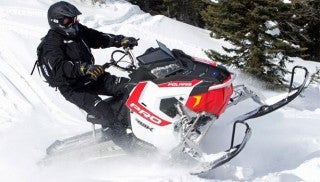
A lightweight, fast reacting snowmobile
Polaris has been receiving some well deserved credit from the media and consumers with the release of its lightweight AXYS RMK chassis. It is no secret that Polaris has been very aggressive in its efforts for total terrain domination. The old RMK in the Pro-Ride chassis was the lightest mountain sled on the market. With the release of the 2016 AXYS chassis, Polaris has only widened the gap between them and the nearest competitor. Polaris has done a good job assembling well engineered components into one package – the 600 Pro-RMK.
Engine Type:Horizontal In-line
Cylinders:2
Engine Stroke:2-Stroke
Valve Configuration:Reed Valve
Displacement:599 / 36.5
Starter:Pull
Turbocharged:No
View Full SpecEngine
Over the years Polaris’ 600 Cleanfire engine has proven itself to be powerful and reliable. Although the 600cc twin did not receive the slick upgrades like the new 800 engine did, it offers instant throttle response and acceleration thanks to its semi-direct injection (SDI). Polaris claims above average fuel economy and power output for the engine in real world riding conditions.
The Cleanfire produces around 130 horsepower, about what the 700s of the early 2000s delivered. That is plenty of power for most western conditions. But, let’s be honest here, in serious deep powder and when riding in steep terrain the smaller displacement and lower powered 600 will struggle keeping up with the 800s. Nonetheless, it will do a good job boondocking in the trees next to the 800s.
COMPARISON: Read our review of the 2016 Polaris 800 AXYS RMK Assault + Video
The 600s, which seem to be the favorite sleds for rental companies and younger riders, teach riders to rely on technique to be successful in the backcountry and not to depend on sheer horsepower to ride out of difficult situations.
Suspension
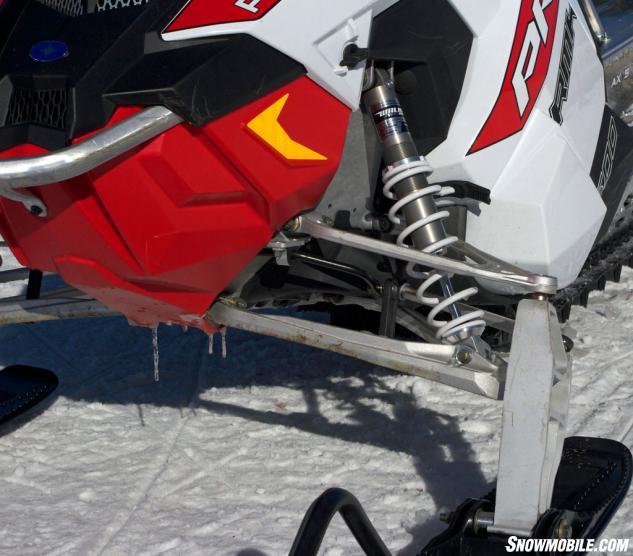 The 600 Pro-RMK introduces industry-first forged A-arms that are 1.5 lbs lighter and much stronger than last year’s design.
The 600 Pro-RMK introduces industry-first forged A-arms that are 1.5 lbs lighter and much stronger than last year’s design.While some OEMs are making their suspensions and track flex, Polaris is doing all it can to make its suspension and chassis packages even more rigid. As the rider makes an input into the snowmobile, that input is not dampened by the suspension or the track. It is delivered straight to the suspension and the rider, providing a much more consistent and predictable reaction by the snowmobile. Instead of trying to outguess how the suspension and track will dampen the rider’s inputs, or how changing snow conditions will affect the way the snowmobile handles, the RMK remains predictable through rider inputs and changing snow conditions. Its rigid track, suspension and chassis gives the RMK a well balanced and predictable ride. Polaris designed new rails that, combined with a rigid geometry, maintains the appropriate amount of weight transfer without overtransferring.
For 2016 Polaris introduced an industry first – forged aluminum A-arms. The new A-arms are one-piece and are 1.5 lbs lighter than the previous ones. Forged A-arms are common in the automotive world and have proven their durability. To get through snow better, Polaris raised the chassis to increase clearance and reduce drag on the underside of the sled. Spindles are also taller to increase clearance. To demonstrate how much taller the spindles are on this snowmobile than the spindles on the RMK Assault, we measured from the bottom of the ski mounting bolt to the top of the spindle. The Assault spindle is 10 inches tall to the top, while the new spindle is 11.5 inches to the top, adding 1.5 inches of clearance to the snowmobile.
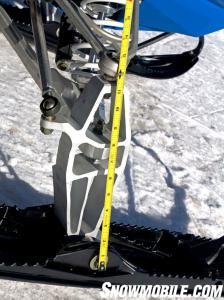 The 600 Pro-RMK’s new spindle with forged A-arm is almost 11.5-inches tall, an inch and a half taller than the older spindle.
The 600 Pro-RMK’s new spindle with forged A-arm is almost 11.5-inches tall, an inch and a half taller than the older spindle.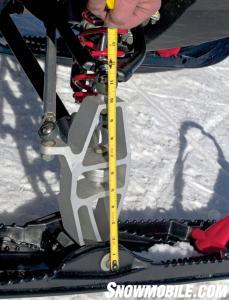 Polaris’ Assault model has chromoly A-arms with the older spindle style, which measures10-inches tall from the bottom of the ski mounting bolt.
Polaris’ Assault model has chromoly A-arms with the older spindle style, which measures10-inches tall from the bottom of the ski mounting bolt.Chassis
New for 2016 is the AXYS RMK chassis. This AXYS chassis is not a trail snowmobile chassis that has been adapted by adding a longer track; it is a mountain-specific platform. Other OEMs should pay attention to this lightweight chassis. Consumers are quickly noticing and it’s why Polaris is not only leading the charge in the lightweight war, but pulling away, virtually uncontested.
Polaris engineers decided that a carbon fiber overstructure was appropriate to reduce weight. Carbon fiber is used with great success in many industries where weight is critical. A lighter chassis makes almost all aspects of riding easier and is most evident on long sidehill pulls.
COMPARISON: Read our review of the 2016 Ski-Doo Summit X T3 154 Review
Polaris’ PowderTrac runningboards were designed for snow evacuation and strength. History has taught OEMs that runningboards build up great amounts of snow, thus increasing the weight of the sled. Polaris has gone to great lengths to minimize snow from building up on Pro-RMK runningboard. You’ll find the RMK dedicates 50 percent of the runningboard to open areas and incorporates integrated traction machined into it.
The innovative QuickDrive now enjoys a few years under its belt with Polaris continuing to be the only company that offers a belt drive from the factory. Polaris claims to have reduced rotational inertia by 21percent. The system is claimed to be maintenance-free and does not need oil or a tensioner system. This adds to the quick revving and quick responding system that is especially desired in powder play.
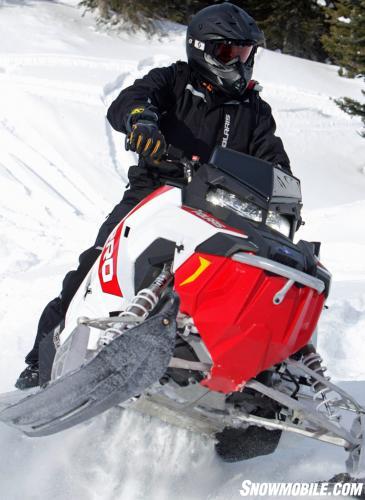 The 600 PRO-RMK comes with Walker Evans Monotube shock, the lightest shocks Walker Evans produces.
The 600 PRO-RMK comes with Walker Evans Monotube shock, the lightest shocks Walker Evans produces.No premium snowmobile would be complete without premium shocks. Polaris specifies Walker Evans Monotube Shocks, the lightest shock that Walker Evans produces. Coil over springs seem to be the favored set up with consumers, even though other manufacturers continue to promote air shocks.
Polaris chose to put the Series 5.1 track under the 600 Pro-RMK. Measuring 15x155x2.4 inches, this track works well with the 600 twin.
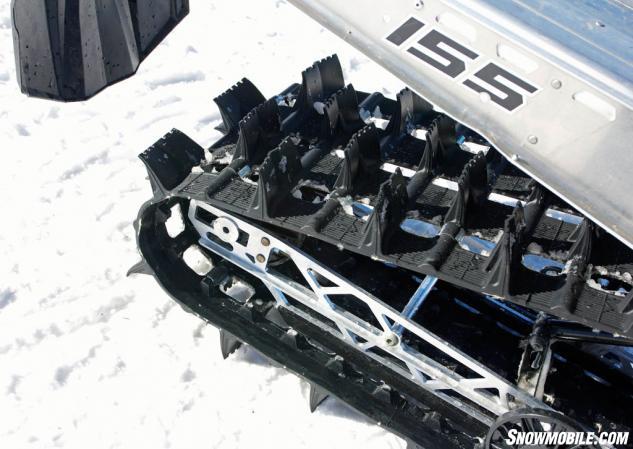 The Series 5.1 15 x 155 x 2.4 track comes standard with the 600 Pro-RMK.
The Series 5.1 15 x 155 x 2.4 track comes standard with the 600 Pro-RMK.Handling
Polaris continues to boast about the legendary balance of its RMK chassis. When we weigh our demo sleds every year, the sleds are lifted up at the steering post. The RMK is consistently the snowmobile most in plane with the flat ground. Balance is one of the unsung heroes of handling characteristics, because so many handling characteristics are dependent upon balance. Along with balance comes predictability. When a chassis is balanced and predictable the rider has a greater amount of control, thus increasing confidence and enjoyment.
Refinements
Since mountain riders typically favor short seats so they don’t get hung up as they cross over, jumping from side to side, Polaris continues to use its PRO-Lite Seat, which is sleek in design and has a great foam density.
COMPARISON: Read our review of the 2016 Arctic Cat M8000 Sno Pro and SE
It is no secret that LED lights are lighter, brighter and require less energy and are taking over all aspects of our life, from our homes, to our automobiles, to aviation. Polaris is capitalizing on the trend, installing them in its AXYS chassis snowmobiles to gain weight savings and brightness. LEDs are nearly one-pound lighter than the incandescent light bulbs formerly installed. Plus, unlike incandescent bulbs, LED lights do not experience filament burnout.
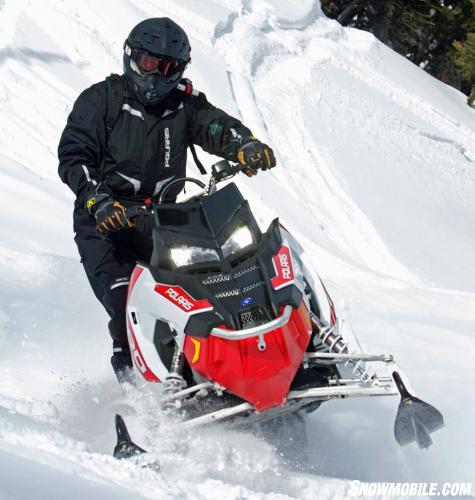 The 600 Pro-RMK is very well balanced, making sidehilling much easier.
The 600 Pro-RMK is very well balanced, making sidehilling much easier.Polaris engineers and designers have taken great care in the design of the side panels on the AXYS chassis. Often times when riding on a steep sidehill, the rider can tip the snowmobile so far that the side panels become the main point where the snow is striking and may actually become a pivot point that pulls the track out of the snow. At this point the rider doesn’t have control of the snowmobile. The snowmobile may act as an elevator and actually slide straight down the sidehill. When the snowmobile is tipped so far that the panel becomes the pivot point, it is called “panel out.” Contrary to what you may read elsewhere, paneling out is a bad thing.
The Bottom Line
When it comes to modern mountain snowmobiles, the aggressive attitude that Polaris has adopted has paid off with industry-firsts such as factory belt drive, forged A-arms and the continuation of the lightest mountain sleds on the market. The complete package that Polaris has assembled for the RMK lineup works well together and has come together to create a lightweight, fast-reacting snowmobile that will please the pickiest of riders.
| 2016 Polaris 600 Pro-RMK 155 Specs | |
| Engine | Polaris Cleanfire two-stroke 599cc; bore/stroke of 77.25mm/64mm; two-cylinder, liquid-cooled; Cleanfire electronic fuel injection system; dry sump lubrication |
| Horsepower | 125+ |
| Drive | Polaris QuickDrive with Polaris P85 driver and TEAM LWT driven |
| Front Suspension | AXYS RMK adjustable A-arm; Walker Evans Monotube shocks; up to 9 in of travel; Gripper skis |
| Rear Suspension | Polaris parallel slide rail RMK Coil-Over; Walker Monotube gas shocks; up to 16 inches of travel |
| Length | 131.0 in |
| Height | 49.125 in |
| Width | 46.5 in |
| Ski Stance | Adjustable 39-40-41-inches |
| Track | 15 x 155 x 2.4 Series 5.1 |
| Brake | Polaris AXYS RMK LWT hydraulic disc brake |
| Weight | 412 pounds (Claimed) |
| Fuel Capacity | 11.5 US Gal |
| Features | Optional storage bags, windshields |
| MSRP | US$11,899 |



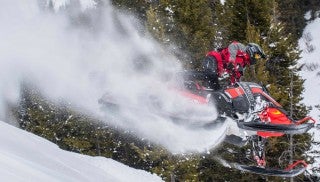
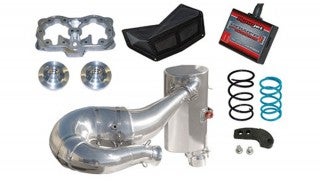



 Your Privacy Choices
Your Privacy Choices